Day 1 of three days of tours – based in North Norfolk today. It was a glorious day, mostly clear skies and sunshine, although the recent run of northerly or north-westerly winds has continued to restrict the flow of early migrants. Still, it was a great day to be out, and we saw some really good birds.
Our first stop and we had barely got out of the car before we could hear the Mediterranean Gulls calling. From up on the seawall, we could see several flying around and a couple of pairs landing on the ground. Even better, they were displaying. A great start. No sign of any terns yet – hopefully they will start to arrive soon.
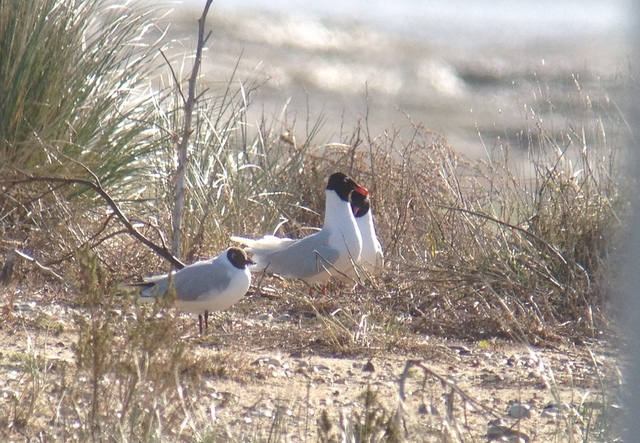 Mediterranean Gulls – pair displaying (with Black-headed Gull, foreground)
Mediterranean Gulls – pair displaying (with Black-headed Gull, foreground)
Out on the mud, there were lots of waders. Loads of Oystercatcher, whirling flocks of Knot and Dunlin, several Grey Plover, a few Curlew and a couple of Turnstone. Not far away, a big group of Brent Geese had come in for an early morning bathe. A pair of Common Buzzards circled over the trees behind.
We drove on westwards. A Barn Owl, surprisingly late to bed, was still out hunting along the field margins. We turned inland and a small diversion produced a Little Owl perched on the top of a barn by the road. It watched us nervously for a couple of minutes, before dropping down out of sight.
 Little Owl – watching us nervously
Little Owl – watching us nervously
We dropped down towards Titchwell, stopping on the way to admire a pair of Grey Partridge in a field. There were lots of Brown Hares as well. Many were lying low in the fields, but we spent some time watching three running around in the winter wheat. There was even a little bit of boxing – it is still March, after all! A pair of Mistle Thrush were still in a field, but there was no sign of the Fieldfare they had been in company with earlier in the week – presumably they had already headed off back to Scandinavia. We saw the odd Yellowhammer, but otherwise there was quite a lot of disturbance from tractors in the fields to walkers on the footpath.
Down in the car park it really felt like spring. Out of the wind, in the sunshine, the Blackthorn was in blossom and a couple of Chiffchaffs were singing. We headed out onto the reserve, and just past the visitor centre we spotted a Water Rail skulking in the ditch by the path. It scuttled along into the vegetation before creeping back out once it thought it wasn’t being watched.
 Water Rail – still in the ditch by the path at Titchwell
Water Rail – still in the ditch by the path at Titchwell
The Thornham grazing marsh pool was drained earlier in the winter and had started to look rather parched in recent weeks. However, after a bit of rain in the last couple of days, it seemed a bit more promising. There was not much to see on the first scan, but pausing to look at the Pied Wagtails feeding round one edge (following a question about White Wagtails), a small bird could be seen bouncing up and down behind. It was immediately obvious that it was a snipe from the dark blackish background colour to the upperparts contrasting with the golden stripes, and behaving quite like that, it could really only be one species. It turned round and we could see the short bill and distinctive face pattern – a Jack Snipe. We watched it feeding quietly on the edge of the rushes.
There were several Marsh Harriers out over the reedbed. One circled up higher than the others and started calling. Then it started displaying as well, twisting and tumbling – great to watch. The reedbed pool held two smart male Red-crested Pochards, with their bouffant orange hairdos. In contarst, the moulting Chinese Water Deer which walked across the saltmarsh was looking decidedly scruffy.
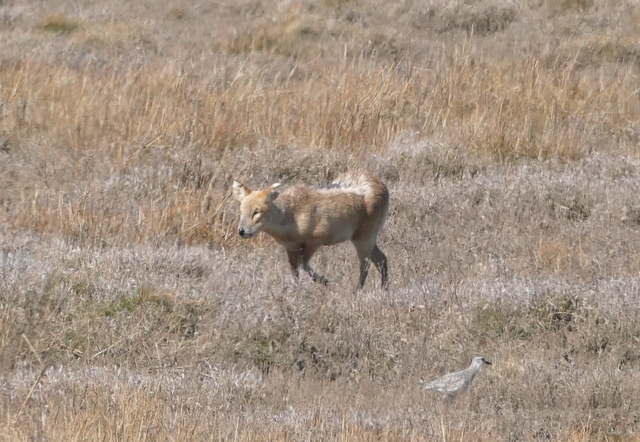 Chinese Water Deer – this scruffy individual was out on the saltmarsh
Chinese Water Deer – this scruffy individual was out on the saltmarsh
The freshmarsh held a good selection of waders and wildfowl. We stopped to admire the ducks, enjoying the still rather high water levels (presumably they will be lowered eventually?!). A drake Shoveler was preening by the path – in the sunlight, its normally green head appeared to glow purple.
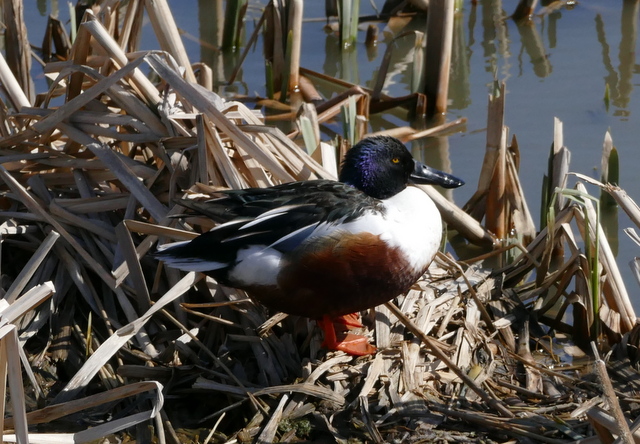 Shoveler – a smart drake preening by the path
Shoveler – a smart drake preening by the path
There were also a few Wigeon, lots of Gadwall and Teal, and the ubiquitous Mallard. The diving ducks were represented by Tufted Duck and Pochard, though numbers appeared to be down on recent weeks, as well as a couple of female Goldeneye. Periodically, groups of Brent Geese dropped in from the saltmarsh towards Thornham or Brancaster.
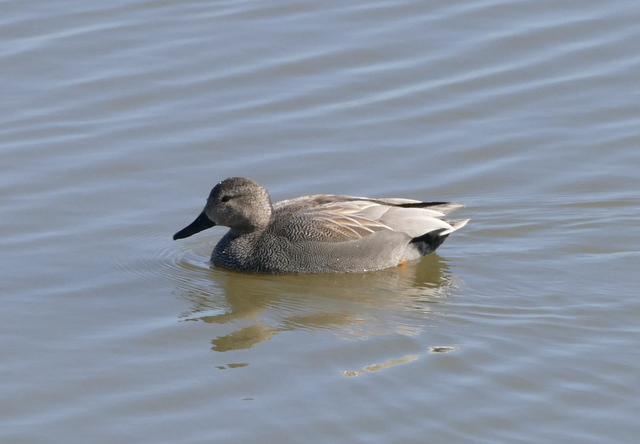 Gadwall – still a firm favourite for those who like their ducks more subtle
Gadwall – still a firm favourite for those who like their ducks more subtle
 Brent Goose – flying in from the saltmarsh
Brent Goose – flying in from the saltmarsh
There were plenty of waders, too. With the tide high out on the beach, the godwits on the freshmarsh were all roosting Bar-tailed Godwit. There was also a little group of Knot bathing, a lone Dunlin and a couple of Turnstone on the islands. A single scaly, winter-plumaged Ruff was joined by a much smaller Reeve. The Avocets were looking much happier with the tops of the islands now out of the water, giving them somewhere to stand without getting their feet wet.
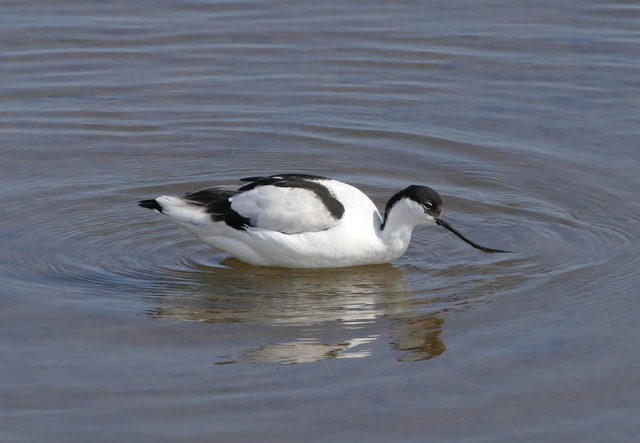 Avocet – feeding by the path again today
Avocet – feeding by the path again today
The Volunteer Marsh also held a good selection of waders. There were a few Black-tailed Godwit here, including one well-advanced in its moult towards its rusty orange summer plumage. There were also plenty still in mostly winter plumage, giving a good opportunity to hone ID skills compared to the Bar-tailed Godwits nearby.
 Black-tailed Godwit – this one still in grey winter plumage
Black-tailed Godwit – this one still in grey winter plumage
There were also lots of Redshank and Oystercatcher, a few more Knot and several Curlew. Several Grey Plover were much admired, and we looked closely at the differences between adults and first winter birds. However, the highlight was a single Spotted Redshank which walked up out of a muddy channel and promptly went to sleep on the bank.
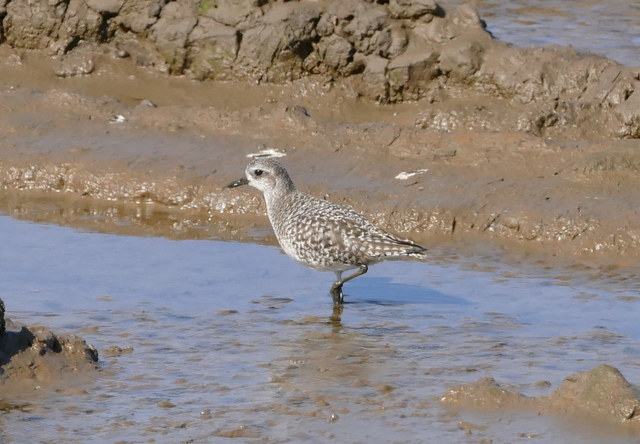 Grey Plover – a smart spangled bird
Grey Plover – a smart spangled bird
The Tidal Pools added Pintail to the days list, though only several females today and no sign of any males. A quick look at the sea gave us several Red-breasted Merganser and a couple of distant Eider.
As we walked back, we stopped again to look at the drained Thornham grazing marsh pool. Standing still, half hidden amongst the rushes, was a Water Pipit. Presumably the same bird which has been present most of the winter, it is now coming into summer plumage. Gone are the black streaks on the underparts, to be replaced by a delicate pink flush across the breast. Smart.
It was getting on for lunchtime, but we made a quick diversion round via the Meadow Trail. There were lots of Chiffchaffs flycatching in the sallows – they have really arrived in good numbers now. A pair of Bullfinch called from the trees, but proved hard to see, before the pink male eventually gave himself up.
 Chiffchaff – lots around Titchwell today
Chiffchaff – lots around Titchwell today
Patsy’s Reedbed itself was very quiet, but we were in for a nice surprise on the walk there. We flushed a couple of Pied-type Wagtails from the path as we rounded the corner and one looked very pale grey above as it flew over the hedge. We walked back and peered into the field beyond, but there were only a few Pied Wagtails there. As we returned towards the screen, we could see half a dozen alba wagtails back on the path and amongst them the unmistakable pale grey back and sharply demarcated black cap of a White Wagtail, the continental sub-species which passes through here on migration. Unfortunately, one of the Pied Wagtails clearly took offence to its foreign cousin and promptly chased it off out towards the reedbed. Still it was great to see, a classic early spring migrant.
After a late lunch, we headed back along the coast to Holkham. Another Barn Owl was hunting along the grassy bank to the east of Lady Anne’s Drive as we arrived. We walked west on the inland side of the pines. The trees were rather quiet today, but we still picked up several Goldcrests, Treecreepers and a selection of tits. Several more Chiffchaffs were singing from the bushes.
We climbed up to the Joe Jordan hide and settled down to scan the grazing marshes. It didn’t take long to spot a Spoonbill dropping out of the trees and flying down to the pool nearby. It seemed to feed for a few seconds, sweeping its bill from side to side through the water, before grabbing a stick from the water and flying back up to the trees with it in its bill. We watched this happen repeatedly over the next half an hour, although it was never clear whether only one individual or several was involved. Nice to see the birds back and keeping busy!
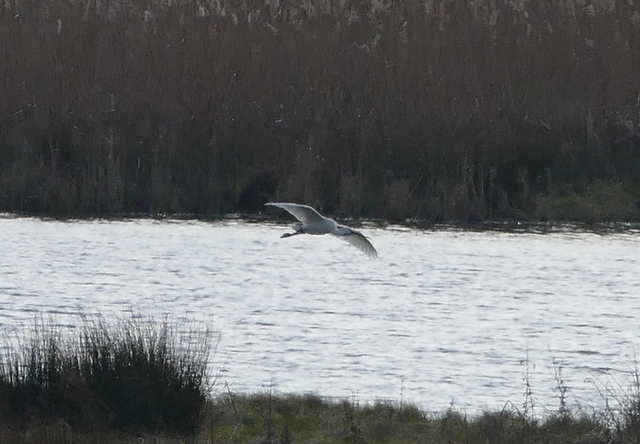 Spoonbill – flying down to collect nest material
Spoonbill – flying down to collect nest material
There was no sign of any White-fronted Geese amongst the numerous feral Greylags, Canadas and Egyptian Geese today – perhaps they have finally departed on their way back to Russia. However, we did find a couple of Pink-footed Geese. Most of their kind already departed last month, but very small numbers still linger. Some, perhaps sick or injured birds, may remain for the summer. The resident super-pale Common Buzzard was visible distantly, perched in a tree over towards the road – it really stood out with its almost white head and breast.
We walked on to the west end of the pines. There were lots of raptors out now. A couple of Red Kites circled lazily over the grazing marsh. A female Sparrowhawk came out of the trees and flew right overhead. A second pale Common Buzzard sat on one of its usual fence posts. There were also a couple more Barn Owls out hunting over the fields, enjoying the late afternoon sunshine.
Another buzzard flew up to the fence posts. Despite the fact that we were looking straight into the sun, its pale head immediately stood out. We walked round into the dunes to get a better look and confirmed our suspicions – it was the Rough-legged Buzzard which has been hanging around for the winter. Surely it must only be a matter of time now before it departs back north? We watched it standing on the post, noting the blackish belly patch contrasting with the pale head. Then it took off and flew a little further along the fence line, giving us a great view of its white tail with a terminal black band, particularly as it landed.
 Rough-legged Buzzard – still out on the grazing marshes this afternoon
Rough-legged Buzzard – still out on the grazing marshes this afternoon
Then it was time to call it a day. The walk back was uneventful, although we reminisced about the highlights of the day and admired the late afternoon weather. It seemed a nice way to end, with great views of the Rough-legged Buzzard. However, we were in the car and driving back up Lady Anne’s Drive when a glance out of the window revealed another Spoonbill feeding on one of the pools right by the road. We leapt out, grabbing cameras and binoculars from the boot and had great views as it swept its bill from side to side through the shallows. A cracking finale.
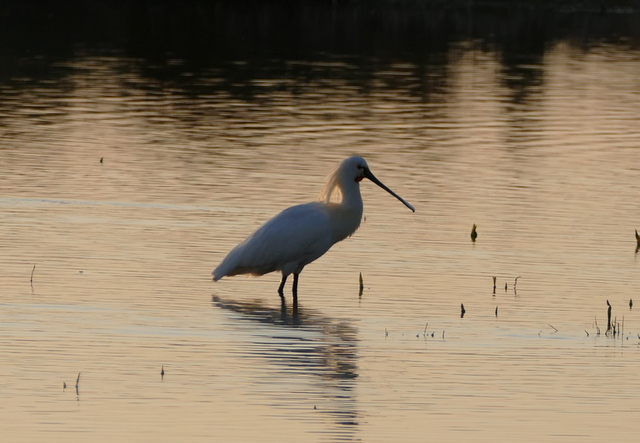 Spoonbill – feeding on a pool by Lady Anne’s Drive as we left
Spoonbill – feeding on a pool by Lady Anne’s Drive as we left
















